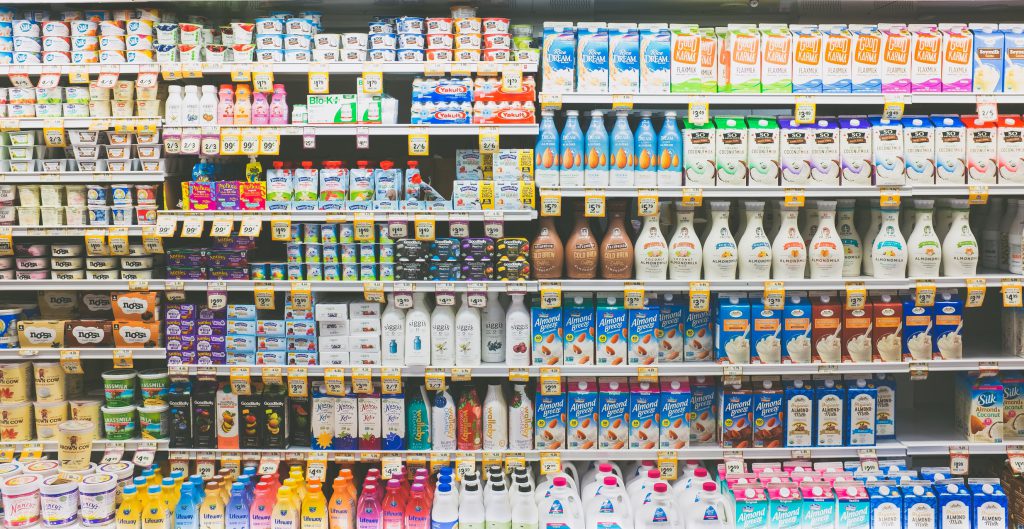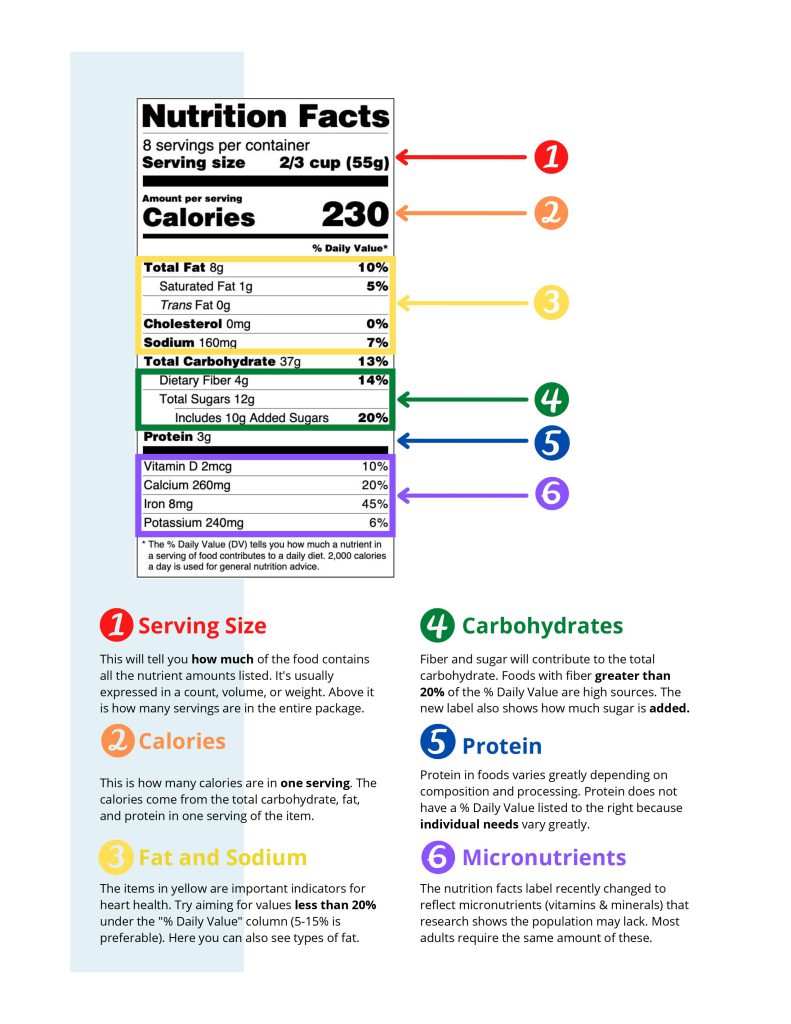When was the last time you studied a nutrition facts label? Wait, let’s start from the top. When was the last time you looked at a nutrition facts label? Sorry, I’m making assumptions. Do you know that packaged foods have a nutrition facts label?
The FDA requires almost all foods to have an up-to-date nutrition facts label. The FDA basically regulates anything you see printed on a food package (name, ingredients, claims, nutrition, contents, etc). Food labels are required by law for almost all food sold in the United States. There are certain specific exemptions like raw fruit and vegetables, deli-type foods, bakery items, and seafood.

I was in the grocery store the other day giving a grocery store tour to a client, and we talked about food labels. He admitted he never turns packages around to read the label; he usually sticks to the list his wife arms him with, weaves in and out of the Saturday crowd and gets outta there.
He said he tries to stick to the list, and doesn’t usually look around for other options but isn’t always happy with the choices once he’s home. To his surprise, once we started looking at food labels he found his options expanded a lot. We talked about portions, how to compare different varieties of the same thing (eg. 1% vs. 2% milk), where to look for added sugar, and where to look for additives.
The fact that he didn’t know much about the nutrition facts label was not a surprise to me at all. Being a registered dietitian, I know that a lot of people don’t read them with as much excitement as I do (Look at the fiber content!! 0 grams added sugar!!). And, you probably don’t want to spend extra time in the store reading and trying to figure out what you’re even looking at when you turn over a package.

So, hi, I’m here to help you. Short of me taking you on an actual grocery store tour, which is one of my favorite things to do, I’ve created a handy nutrition facts label one-pager and outlined some more details below. (Seriously though, I offer grocery store tours in my services!)

Here’s some more info:
- Serving Size
- This is really important for the rest of the label to make sense. All of the values below refer to the amount listed in the serving size. If you look at the example above, the food is 230 calories. That’s 230 calories per 2/3 cup. This can trip you up if you’re looking at the label and think the entire thing is 230 calories. You will see right above the serving size how many servings per container there are. So in reality, this food has 1,840 calories per container (230 calories x 8 servings). Big difference if you don’t understand how to read serving sizes. Serving sizes will usually be expressed in count (11 chips), weight (55 grams) or volume (2/3 cup).
- Calories
- This is pretty straightforward. As explained above, this is the amount of energy (calories) that a food has per the serving size listed. If you’re eating more than one serving, just do a little math to figure out how many calories you’re getting. The food label was recently updated and you may notice that the calories are in a larger print than other lines on the label.
- Fat and Sodium
- I grouped these together so I could talk about the 5/20 rule. Of course, not all fat and sodium are bad for you. There are plenty of healthy fats, and our bodies really need sodium to function. In fact, you can eat something high in saturated fat and sodium every once in a while and it’s okay! Hi, pizza!
- Under total fat, you will see what types of fats are in the food. Some are saturated (eg. saturated like butter, coconut oil, animal fat), some are unsaturated (eg. monounsaturated, polyunsaturated like vegetable oils), and less these days you’ll find trans (junkie unsaturated fats turned into saturated fats and your body hates them). Fat and sodium will have a % listed to the right. The % Daily Value is what someone would need on an average 2,000 calorie/day diet. This is not everyone by any means, but it’s average.
- The 5/20 rule is this: if you see 20% or up for the daily value, that means the food is high in this nutrient. This is great for things like fiber and the vitamins listed at the bottom, but not great for fat, sodium, cholesterol and added sugars. If you see 5% or lower for the daily value, that means the food is low in those nutrients. This is great for things like fat, sodium, cholesterol and added sugar, but not great for fiber and vitamins. This is a guideline and of course not all foods have to follow this rule. It just gives you a good understanding of what’s going on in there.
- Carbohydrates
- Did reading that word give you anxiety? Stop it! Under carbohydrates, you’re going to see the amount of fiber and total sugar that contribute to the value. Fiber is important, as mentioned above, partly because it helps your body regulate the carbohydrates you’re eating. Fiber contributes to our gut health, lowers cholesterol and keeps us full. Eat your damn fiber-rich carbs! Anyway, total carbohydrates is pretty straightforward as well.
- Protein
- Protein amounts vary so much from food to food. Protein is found from traditional sources (meat, poultry, fish, eggs, dairy) but also in grains, beans/legumes, and soy products. So a piece of bread may be predominantly carbs, but it will also have a couple grams of protein as well. There is no daily value for protein because this is truly the value that varies the most from person to person. Most people generally eat similar amounts of fat and carbs, but protein is very individualized.
- Micronutrients
- Micronutrients are nutrients we need in small amounts, like vitamins and minerals. Usually we require a number of milligrams per day, versus something like protein or fat where we require a number of grams per day. Recently, the FDA changed what we see in this section based on research that suggested Americans aren’t getting enough of certain nutrients. Calcium and iron were on the old food label, but Vitamin D and Potassium replaced Vitamin A and Vitamin C.
That was probably the most you’ve ever thought about a food label, and I hope that it helped clear up some of your questions! If you want to learn more or have additional questions, never ever hesitate to reach out to me via contact form or email.
